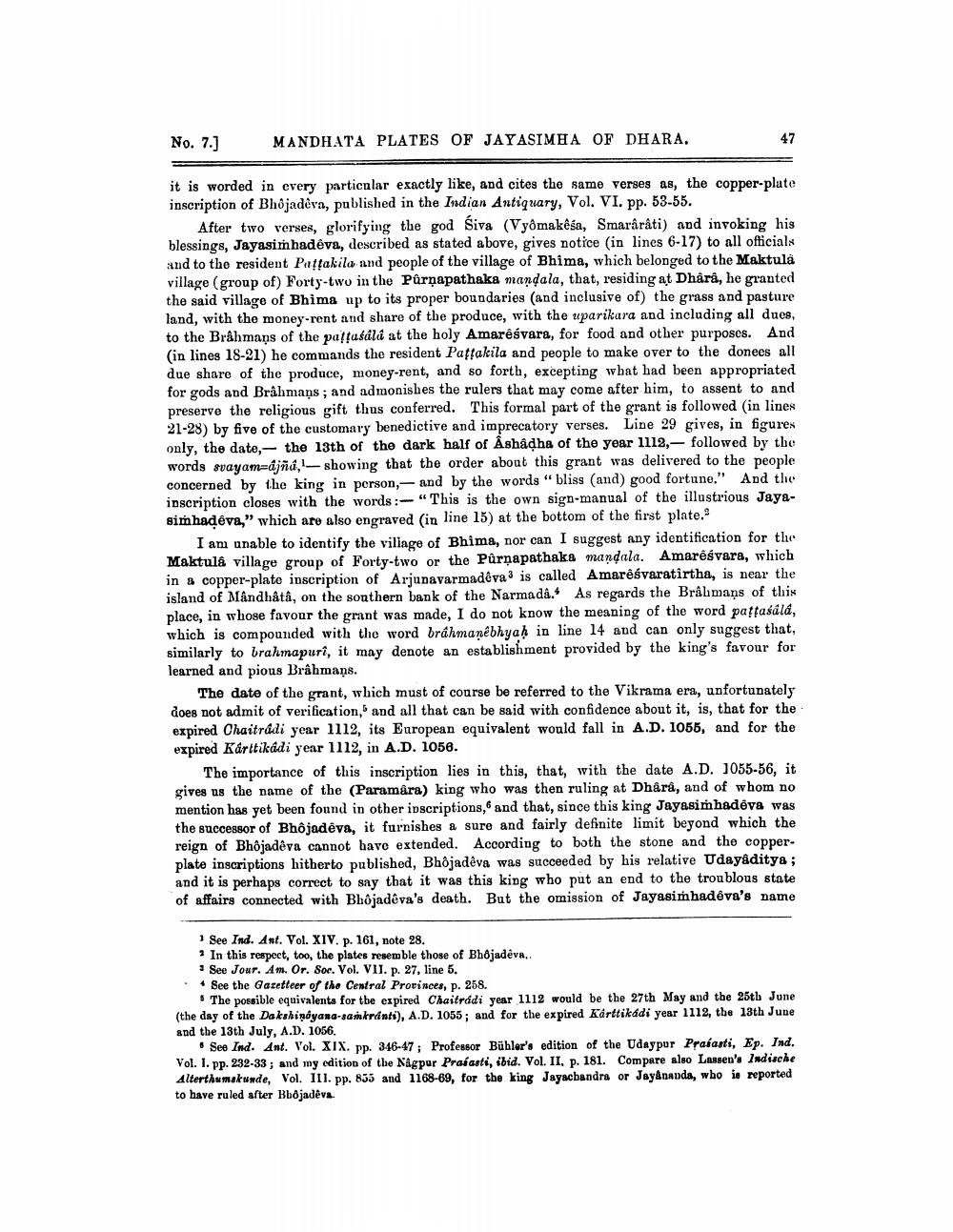________________
No. 7.]
MANDHATA PLATES OF JAYASIMHA OF DHARA.
it is worded in every particnlar exactly like, and cites the same verses as, the copper-plate inscription of Bhöjadeva, published in the Indian Antiquary, Vol. VI. pp. 53-55.
After two verses, glorifying the god Siva (Vyðmakeśa, Smarârâti) and invoking his blessings, Jayasimhadeva, described as stated above, gives notice (in lines 6-17) to all officials and to the resident Pattakila and people of the village of Bhima, which belonged to the Maktula village (group of) Forty-two in the Pûrņapathaka mandala, that, residing at Dhårå, he granted the said village of Bhima up to its proper boundaries (and inclusive of) the grass and pasture land, with the money-rent and share of the produce, with the uparikara and including all dues, to the Brahmans of the pattusálá at the holy Amarêśvara, for food and other purposes. And (in lines 18-21) he commands the resident Pattakila and people to make over to the donees all due share of the produce, money-rent, and so forth, excepting what had been appropriated for gods and Brahmans; and admonishes the rulers that may come after him, to assent to and preserve the religious gift thus conferred. This formal part of the grant is followed (in lines 21-28) by five of the customary benedictive and imprecatory verses. Line 29 gives, in figures only, the date, the 13th of the dark half of Ashadha of the year 1112,- followed by the words svayam-djñá, showing that the order about this grant was delivered to the people concerned by the king in person, and by the words "bliss (and) good fortune." And the inscription closes with the words :-“This is the own sign-manual of the illustrious Jayasimhadeva," which are also engraved (in line 15) at the bottom of the first plate.
I am unable to identify the village of Bhima, nor can I suggest any identification for the Maktulâ village group of Forty-two or the Purņapathaka mandala. Amarêśvara, which in a copper-plate inscription of Arjunavarmadêva is called Amarèśvaratirtha, is near the island of Mandhata, on the southern bank of the Narmada. As regards the Brålmans of this place, in whose favour the grant was made, I do not know the meaning of the word pattasala, which is compounded with the word brahmanêbhyaḥ in line 14 and can only suggest that, similarly to brahmapuri, it may denote an establishment provided by the king's favour for learned and pious Brâhmans.
The date of the grant, which must of course be referred to the Vikrama era, unfortunately does not admit of verification, and all that can be said with confidence about it, is, that for the expired Chaitrådi year 1112, its European equivalent would fall in A.D. 1055, and for the expired Karttikadi year 1112, in A.D. 1056.
The importance of this inscription lies in this, that, with the date A.D. 1055-56, it gives us the name of the (Paramara) king who was then ruling at Dhårå, and of whom no mention has yet been found in other inscriptions, and that, since this king Jayasimhadeva was the successor of Bhôjadêve, it furnishes a sure and fairly definite limit beyond which the reign of Bhôjadeva cannot have extended. According to both the stone and the copperplate inscriptions hitherto published, Bhojadeva was succeeded by his relative Udayaditya ; and it is perhaps correct to say that it was this king who put an end to the troublous state of affairs connected with Bhöjadeva's death. But the omission of Jayasimhadêva's name
1 See Ind. Ant. Vol. XIV. p. 161, note 28.
In this respect, too, the plates resemble those of Bhojadeva, * See Jour. Am. Or. Soe. Vol. VII. p. 27, line 5. . See the Gazetteer of the Central Provinces, p. 258.
The possible equivalents for the expired Chaitrádi year 1112 would be the 27th May and the 25th June (the day of the Dakshinayana-sankranti), A.D. 1055; and for the expired Kárttikadi year 1112, the 13th June and the 13th July, A.D. 1056.
• See Ind. Ant. Vol. XIX. pp. 346-47; Professor Bühler's edition of the Udaypur Praiasti, Ep. Ind. Vol. I. pp. 232-33 ; and my edition of the Nagpur Prahasti, ibid. Vol. II, p. 181. Compare also Lassen's Indische Altertumskunde, Vol. Ill. pp. 835 and 1168-69, for the king Jayachandra or Jay&navda, who is reported to have ruled after Bböjadeva




